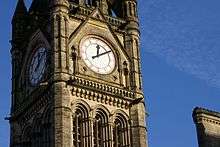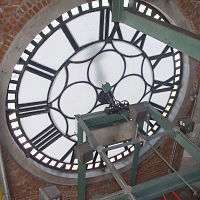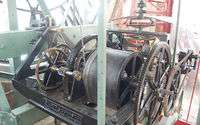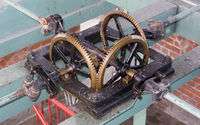Gillett and Johnston is a clock and formerly bell manufacturing business in Croydon, England.
History
William Gillett started a clock making business on Union Road in Croydon, England in 1844. Charles Bland became a partner in 1854 and the company became known as Gillet and Bland. In 1877, Arthur Johnston bought a partnership in the business and soon established a bell foundry. The company became known as Gillett, Bland & Co until Charles Bland's death in 1884 when the company name was changed to Gillett & Co. The name Gillett & Johnston seems to have been used from around 1877.[1] Johnston's son Cyril perfected the tuning of bells which established Gillett & Johnston as one of the premier carillon manufacturers in the world for many years. Many of the installations were in North America, with the majority of installations taking place from 1922-1939.

The John Wanamaker Memorial Founder's Bell

The clock on
Manchester Town Hall was produced by Gillett & Bland, the predecessor to Gillett & Johnston
In 1925, Rodman Wanamaker, patron of the Wanamaker Organ, commissioned a 16-ton tuned bell as a memorial to his father, the Philadelphia merchant John Wanamaker. When it was cast the next year, it was the world's largest tuned bell. The firm had successfully revived an old technique for tuning bells to themselves by shaving the bell's interior to bring the bell's natural harmonic series in tune with itself. This bell is located in the belfry of One South Broad Street, a building originally known as the Lincoln-Liberty Building (Wanamaker's new Men's Store) and later the PNB bank building (One South Broad). Leopold Stokowski was one of the many admirers of its tone. Originally the bell could be swung on special occasions; today a large hammer is used to strike the hours.
Perhaps the firm's most prestigious installation was for the Laura Spelman Rockefeller memorial carillon at the Riverside Church in New York City. The carillon has the largest note span of any carillon and contains the largest tuned bell in the world. The Low C "bourdon" of the carillon weighs 20 tons.
Cyril Johnston died in 1950. The bell foundry closed in 1957. The firm's last bell installation was the carillon for the Beaumont Tower at Michigan State University in 1957.
The foundry, located in Croydon, England, was demolished in 1997. The Croydon site notes how from 1844 to 1950, over 14,000 tower clocks were made at the foundry.
Gillett & Johnston (Croydon) Ltd is now located in Bletchingley, Surrey and still a family business which travels the world testing experimental carillon restoration techniques, reinstating obsolete and inferior carillon components, making, repairing, servicing, and maintaining clocks & Bells.
Later Foundry history
This bell factory is now a church of the Emmanuel Inspirational Church of God - "Emmanuel Inspirational Church of God". . It was purchased in 2003 after being vacant from the closure of the factory in 1997. Birds took up residence in this vacant building until the purchase of a section of this bell factory was completed.
Gillet and Johnston as Clockmakers continue to this day on other premises in Croydon.
| The following pictures are from the Old Port of Montreal clock tower |
|---|
| Escapement section with weight cable drum |
| Escapement section with weight cable drum |
| 4 faces distributing gears |
| Hours hand downgear & minutes hand counterweight |
|
References
External links
|
|---|
| Background and
terminology | | |
|---|
| Bell founders
and foundries | |
|---|
| | Types | |
|---|
| | Bellringing | |
|---|
| | Notable bells | |
|---|
|










